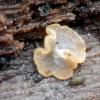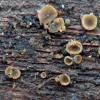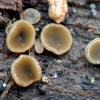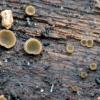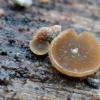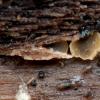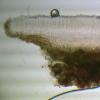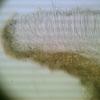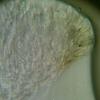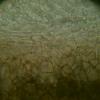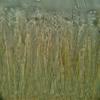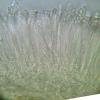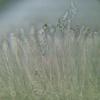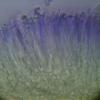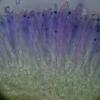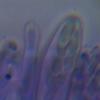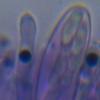
29-12-2025 17:44
Isabelle CharissouBonjour,J'aimerais savoir si d'autres personnes au

29-12-2025 17:12
 Bernard CLESSE
Bernard CLESSE
Bonjour à toutes et tous,Pourriez-vous m'aider à

12-11-2021 00:03
Lepista ZacariasHi everybody,A week ago in my fiels trip I noticed

29-12-2025 17:01
Gernot FriebesHi,I'm looking for help with this hyphomycete with

29-12-2025 08:30
Hello.A tiny ascomycete sprouting under Juniperus

29-12-2025 10:15
Hulda Caroline HolteHello, I found and collected this propoloid ascom

29-12-2025 09:38
Oskari VirtanenHi,could anyone help me identify this, I suspect P
?Mollisia with amber-color on bark of Tilia
Perz Piotr,
21-10-2007 14:55
I have a pretty Mollisioid fungus wiht amber colors. Mikro agree with Mollisia in all respect EXCEPT paraphyses - my fungus oes not have REFR+ VB's !!
KOH-
Asci IKI-
CRZS+
OCI +/- 1
Sp. (5,0) 5,4 – 6,9 (7,3) x (1,8) 2,0um – 2,1 (2,26)um
Sp. 1-celled
With Andreas Key I'm coming to:
46 Sp. 2-3 µm breit 47
46* Sp. 1,2-2 µm breit 48
47 Randhaare dunkel braun, Endzellen keulig, Apo. gesellig, trockenresistent M. ligni
47* Randhaare subhyalin, Endzellen kaum verbreitert, Apo. büschelig M. depressula
PAK 4373 ist als M. depressula x inexula bezeichnet. Welcher Name ist gültig? Ein weiterer rezenter Fund von Staub scheint völlig identisch!
SV Sp. 7-9 x 2,5-3 µm [lebend], meist septiert, Öl ca. 1: biguttulat, globose Zellen gelb
gefärbt und gelblicher Farbstoff löslich, Apo. oliv(gelb-)grünlich M. viridula
vielleicht nur eine überständige Kollektion von ???
48 Sp. 5-6,8 x 1,2-1,8 µm, Apothezien büschelig auf ?stromatisiertem Holz M. caespiticia
48* Sp. 3,5-5,5 x 1,2-1,8 µm (PAK 4406: 5-7,5 x 1,8-2,2, ob identisch?), Apo. nicht büschelig,
Randzellen ? deutlich, subhyalin M. sublividula (PAK 4408)
In PAK (H) sind drei Belege von M. sublividula, von denen einer eine Cistella spec. darstellt.
Perz Piotr,
21-10-2007 14:56
Perz Piotr,
21-10-2007 15:00
Perz Piotr,
21-10-2007 15:04
Re:?Mollisia with amber-color on bark of Tilia
Some makros in hi-res: http://wwkk.mikologia.pl/temporary/ascofrance/Mollisia,%20PP%2020071006-001%20makro.zip
More mikros: http://wwkk.mikologia.pl/temporary/ascofrance/Mollisia,%20PP%2020071006-001%20mikro.zip
best wishes
Pimpek / Poland :D
More mikros: http://wwkk.mikologia.pl/temporary/ascofrance/Mollisia,%20PP%2020071006-001%20mikro.zip
best wishes
Pimpek / Poland :D
Hans-Otto Baral,
21-10-2007 22:56

Re:?Mollisia with amber-color on bark of Tilia
Hi Piotr
I think your species is better placed in Pyrenopeziza. The yellow-amber exudate is also typical of some collections which I have placed on the DVD as "Pyrenopeziza" without species epithet, viz. HB 7620b, 7628b and 8006. These are xerotolerant taxa inhabiting the inner face of bark (Fagus), but differ rather strongly among another, e.g. in spore size and size of LBs. Since I have only very few finds seen, I am far away from a species concept, and cannot tell if one of these is conspecific with yours.
I am very surprized about the deep blue drop in each paraphyses of your photos (I assume this is vital staining with CRB). Usually Pyrenopeziza has one or more globose SCBs in the paraphyses which do not stain in CRB. So this should be a vacuole (?).
Zotto
I think your species is better placed in Pyrenopeziza. The yellow-amber exudate is also typical of some collections which I have placed on the DVD as "Pyrenopeziza" without species epithet, viz. HB 7620b, 7628b and 8006. These are xerotolerant taxa inhabiting the inner face of bark (Fagus), but differ rather strongly among another, e.g. in spore size and size of LBs. Since I have only very few finds seen, I am far away from a species concept, and cannot tell if one of these is conspecific with yours.
I am very surprized about the deep blue drop in each paraphyses of your photos (I assume this is vital staining with CRB). Usually Pyrenopeziza has one or more globose SCBs in the paraphyses which do not stain in CRB. So this should be a vacuole (?).
Zotto
Perz Piotr,
21-10-2007 23:24
Re:?Mollisia with amber-color on bark of Tilia
Hi Zotto,
Oh gosch!! How can I forgett about Pyrenopeziza ?! Some of my Pyrenopezizas (20060611-002E or 20060708-006) doea also have golden exsudate !
Yes, this is vital. This deep blue drops come after few seconds. After adding CRB this drops are not visible and after few seconds they are coming.
Oh gosch!! How can I forgett about Pyrenopeziza ?! Some of my Pyrenopezizas (20060611-002E or 20060708-006) doea also have golden exsudate !
Yes, this is vital. This deep blue drops come after few seconds. After adding CRB this drops are not visible and after few seconds they are coming.
Perz Piotr,
21-10-2007 23:26
Re:?Mollisia with amber-color on bark of Tilia
Thanks a lot - on bark of Tilia I saw hundrets Apos, so I can better studying this species and I will do this.
best wishes
Piotr
best wishes
Piotr
Hans-Otto Baral,
22-10-2007 13:31

Re:?Mollisia with amber-color on bark of Tilia
Such blue-violet drops which are induced by CRB inside the living vacuole are called metachromatic corpuscules (MCs). They are generally formed inside vacuoles, and they are a classical prove for vitality. I know them only from those vacuoles which do not contain any refractive substance. So at the place where this striking drop is formed, you can be sure there is a vacuole which is hardly perceptible without staining.
Zotto
Zotto


